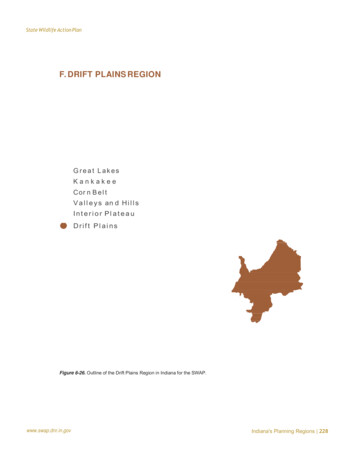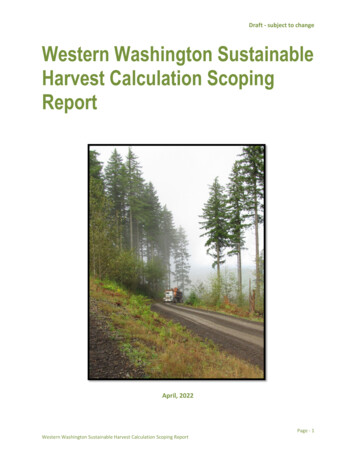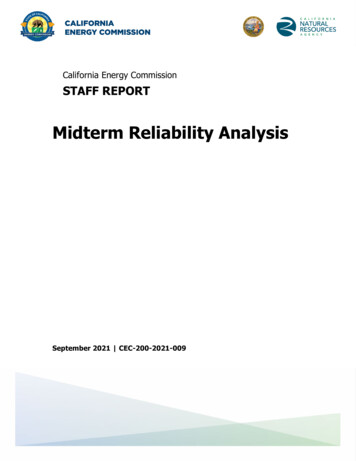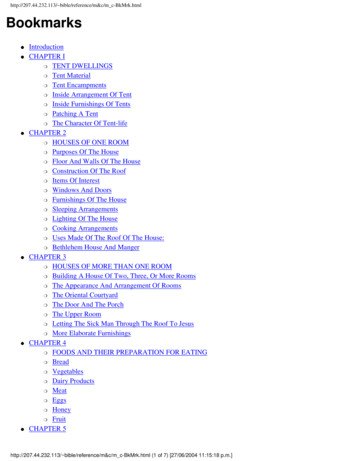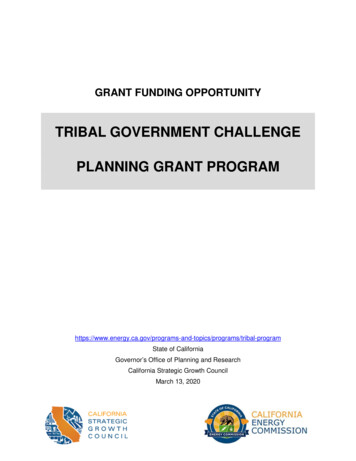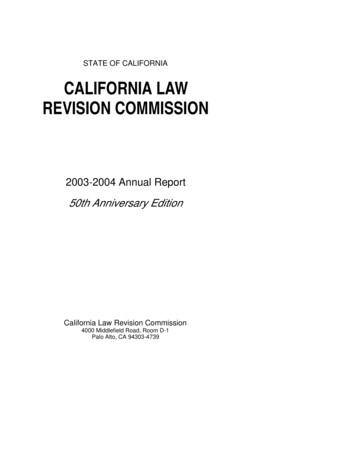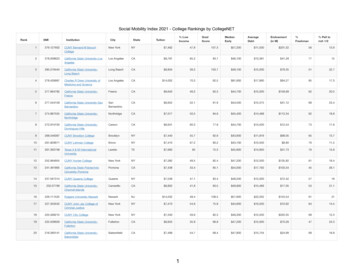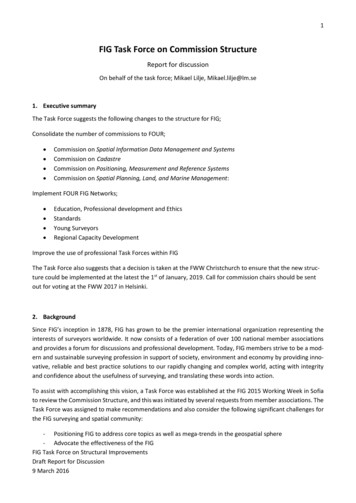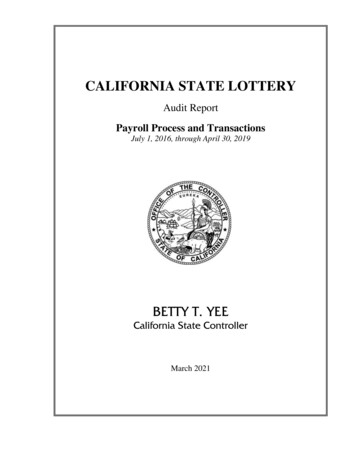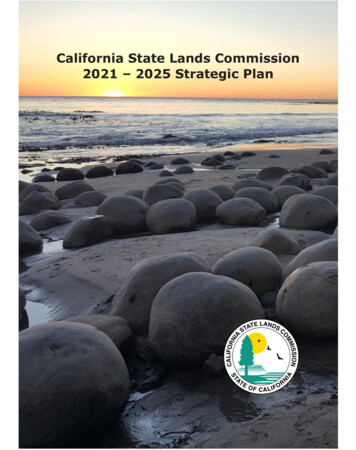
Transcription
California State Lands Commission2021 – 2025 Strategic Plan
LETTER FROM THE COMMISSIONERSA Message to Residents of the Golden StateThe State Lands Commission is pleased to offer our 2021-2025 Strategic Plan, guiding us in atime that calls for being open, flexible, and forward-thinking.This plan takes stock of the world as it presents itself in this new decade and is the result of bothreflection and a focused action: listening. We sought out diverse and varied voices from acrossour state to help us understand, consider, and interpret issues throughout our immense andvaried landscape. We listened, then brought the initial findings together and asked for morefeedback during public meetings and in further listening sessions with California TribalGovernments, Commission staff, key stakeholders, and trustees. The result is a plan offered bythe Commission but reflecting the voices and input from community and industry sectorsstatewide.Through its actions, the Commission secures andsafeguards the public’s access rights to naturalnavigable waterways and the coastline andpreserves irreplaceable natural habitats for wildlife,vegetation, and biological communities.This plan directs us in our need to address issues such as climate change and the resulting sealevel rise, environmental justice, sustainability and opportunities with renewable resources, socialjustice and equity, and the promotion and educational opportunities surrounding public access.The plan leverages technology for innovation, invites incorporation of blue and green economies,and outlines contemporary strategies that are future-oriented. Every part of this plan has beenshaped with the knowledge that our state is immense, representing many different thoughts andneeds, and that the Commission’s role is to be a connection point and to provide collaborativeleadership.This plan enables the Commission to adapt to emerging challenges, while creating a meaningfulframework to prompt state policy goals, promote public access, and enforce the protections of thePublic Trust Doctrine. The Commission and its staff are committed to implementing the goals andstrategies in this strategic plan, continuing to be a model of effective, nimble government,providing the highest levels of stewardship and transparency, and embracing opportunities forinclusiveness and representation in all aspects of our public engagement.CSLC Strategic Plan 2021–2025i
The challenges that we have experienced with the COVID-19 pandemic—the impacts on oureconomy, and the changing nature of our industries and communities—mean we will need to worktogether as we navigate upcoming challenges and additional opportunities. Through partnerships,communication, and with the help of our guiding principles and values, we can develop solutionsand a way forward for Californians, our public lands, and our collective future.We hope you will continue to stay engaged with the Commission and to lend your voice to thework we do on behalf of all Californians. We want to hear from you!Best Regards,California State Lands CommissionBetty T. YeeEleni KounalakisKeely BoslerState Controller, MemberLieutenant Governor,ChairDirector of Department ofFinance, MemberThere are many ways for you to connect with the Commission, to participate in the decisionmaking process, and to stay up-to-date on Commission activities. Attend public meetings, which are held throughout the year and in accordance with theBagley-Keene Open Meeting ActSubmit a written comment before a public meetingRead staff reports—which are posted to our website regularly—from the public meetingsSend us an emailSubscribe to our e-listsContact a representative in any of our field officesWe look forward to hearing from you!CSLC Strategic Plan 2021–2025ii
TABLE OF CONTENTSMISSION . 1EXECUTIVE HIGHLIGHTS . 2ABOUT THE STATE LANDS COMMISSION . 4History . 4Public Trust . 4California State Lands Commission Jurisdictional Map . 5Revenue . 6Integrity . 6Activities . 6Vision . 6Values . 6Guiding Principles. 7REFLECTING ON ACCOMPLISHMENTS . 10DRIVERS OF CHANGE. 12Climate Change and Sea-Level Rise . 12Environmental, Economic, and Social Injustice . 13Support of Tribal Self-Governance and Self-Determination . 15Evolving Public Trust Principles and Values. 16Post-Petroleum Era . 16Renewable Economies and Sustainability . 17Policy Configuration . 17Technological Advancements . 18Workforce Investment . 19CALL TO ACTION . 20STRATEGIC FOCUS AREAS AND GOALS . 21Leading Climate Activism . 21Prioritizing Social, Economic, and Environmental Justice . 21Partnering with Sovereign Tribal Governments and Communities . 22Meeting Evolving Public Trust Needs . 22Leveraging Technology . 24Committing to Collaborative Leadership. 24Building a Reimagined Workforce. 25ADDITIONAL RESOURCES . 26PHOTO CREDITS. 27CSLC Strategic Plan 2021–2025i
MISSIONThe California State Lands Commission provides thepeople of California with effective stewardship of thelands, waterways, and resources entrusted to its carebased on the principles of equity, sustainability, andresiliency, through preservation, restoration,enhancement, responsible economic development,and the promotion of public access.CSLC Strategic Plan 2021-20251
EXECUTIVE HIGHLIGHTSThis document was developed in 2020—a yeardefined by change and challenge. Created in themidst of a global pandemic and a time whenCalifornia was experiencing the emergingconsequences of climate change, the 2021-2025California State Lands Commission Strategic PlanUpdate (Update) reflects the need to rapidlyadjust and evolve to meet the challenges oftoday and tomorrow. The Update reflects anarray of insights garnered from the public, staff,sovereign tribal partners, and a range ofstakeholders as they viewed the future from theiraltered way of life in an increasingly virtualworld.Change is inevitable, but how the Commissionresponds to the challenges that change brings,and how it adapts and embraces theopportunities that come from it, has a profoundeffect on the results. For the Commission, thismeans that strategic planning is not just anexercise completed once every five years. TheCommission’s strategic planning is dynamic andresponsive, driving deliberative action every dayin all that it does.In many ways, this Update was well-timed. In2020, the state and nation collectively began toreview, analyze, plan, and look ahead to how wecan do better, be more inclusive, and makedecisions that protect our environment as climatechange accelerates. Inclusivity, accessibility,equity, sustainability, and environmental justiceserve as foundational values and intersectionallenses through which to view each application,process, issue, and decision. The Commissionkeeps these values top-of-mind as it approachesall activities and statewide responsibilities.As an Update, the plan considers theCommission’s historic roles, accomplishments,and results it has achieved during the five yearsof the previous Strategic Plan. The workcompleted over these years took many forms,including: Adopting an extensive EnvironmentalJustice Policy and Implementation PlanEstablishing annual operations plans thatalign with our overall Strategic PlanCSLC Strategic Plan 2021-2025 Providing, in partnership with theCalifornia Department of Justice, a legalguide detailing the public’s rights toaccess and use California’s navigablewaterways Launching the 2019 OSCAR system(Online System for Customer Applicationsand Records) to streamline and automateapplication and permitting processes Implementing, through the MarineInvasive Species Program, the first oftheir kind in the U.S., and one of the firstin the world, biofouling managementregulations to better protect Californiawaters from species introductions Offering full virtual access and on-demandreplays for all Commission meetings Adopting a meaningful and mutuallybeneficial Tribal Consultation Policy Returning over 16,000 acres of land to theCalifornia Coastal Sanctuary to never bedeveloped for offshore oil or gasproduction Generating revenue for the State ofCalifornia general fund and California’sState Teachers Retirement Systemthrough leasing activities Expanding oil spill prevention activitiesand staff-led monitoring programsJust as important as those results were how theywere achieved. By working together,collaborating, and strengthening partnerships,the Commission achieved more meaningful andeffective outcomes.This Update also attempts to address thechallenges and opportunities of the unsettlingtime the Commission now encounters. Theseinclude the need to: Proactively address climate change andsea-level rise Justly transition to a post-petroleumeconomy2
EXECUTIVE HIGHLIGHTS Ensure environmental and social justicethrough our decisions, actions, andactivities Exercise leadership as conveners andbuilders of consensus on vexing crosssector issues and to establish policyalignment Explore the evolving Public Trustprinciples to reflect the values and needsof a changing society to ensure PublicTrust lands and resources are protectedand accessible for all people of California Embrace and safeguard multi-benefitSchool Lands and resource managementstewardship that equitably balancesresponsible local and regional economicdevelopment, supports living wages,environmental protection, and revenuegeneration Redouble technological advancement andinnovation efforts to better serve thepeople of CaliforniaAs is the case with many complex issues, thenecessary responses to each one often intersectwith other drivers. For example, strategic goalsand actions addressing climate change andtransitioning to a post-petroleum economy willinvolve revisiting appropriate uses of Public Trustlands and protection of Public Trust resources.The Commission’s values and guiding principlesprovide the overarching foundation for everystrategy and action. Working with the values andguiding principles in mind will support decisionmaking that provides sustainable, equitableCSLC Strategic Plan 2021-2025benefits. The plan sets forth actions to unify stateagencies for environmental protections thatprovide coastal resiliency grounded in science,partnerships, communication, and local support.By working with partners; listening to the peopleof California; looking for new and innovativeways to manage lands, natural resources, andbusinesses in California; and prioritizing actionsand activities that put all people at the center ofthe conversation, the Commission achievesbetter results. These results must be sharedequitably and enjoyed by all people of California,both now and in the future.In addition to affirming its ongoing commitments,the Update includes new strategic focus areas,goals, and actions. Many actions will yield nearterm results, while others represent investmentsin a series of steps to be taken to achieve longterm outcomes. The featured strategies are:1. Leading Climate Activism2. Prioritizing Social, Economic, andEnvironmental Justice3. Partnering with Sovereign TribalGovernments and Communities4. Meeting Evolving Public Trust Needs5. Leveraging Technology6. Committing to Collaborative Leadership7. Building a Reimagined WorkforceFor more information on the strategies, weencourage you to explore this full Strategic PlanUpdate.3
ABOUT THE STATE LANDS COMMISSIONStrategic plans consider four basic things: Where an organization has been andwhere it is now The drivers of change the organizationmust navigate and leverage to besuccessful in the future The optimal responses to those drivers ofchange The strategies and actions needed toachieve the desired resultsThe Commission is committed to performing allthe necessary duties required to achieve itsmission. This plan focuses on the strategiesrequired to successfully meet the demands of thefuture.The following establishes the foundation for thestrategies. It considers the rich history of theCommission, its vision for the future, the valuesand principles driving its culture and decisions,and its success in achieving goals outlined in theprevious 2016-2020 California State LandsCommission Strategic Plan (Strategic Plan).HistoryEstablished in 1938 by the California Legislature,the Commission manages four million acres oftide and submerged lands and the beds of naturaland navigable rivers, streams, lakes, bays,estuaries, inlets, and straits. These are oftenreferred to as sovereign lands or Public Trustlands and stretch from the Klamath River andGoose Lake in the north to the Tijuana Estuary inthe south and the Colorado River in the east, andfrom the Pacific Coast three miles offshore in thewest to world-famous Lake Tahoe in the east;and includes California’s two longest rivers, theSacramento and San Joaquin. The Commission isalso the trustee of approximately a half-millionacres of land, known as School Lands, that weregranted to the state by the U.S. Government in1853, and which are managed for the benefit ofthe State Teachers Retirement System. TheCommission’s Public Trust lands and SchoolCSLC Strategic Plan 2021-2025Lands are each subject to specific statutory andcommon law trust responsibilities that theCommission carries out on behalf of the state.For more detail on the types of lands managed bythe Commission, please see the AdditionalResources section and map at the end of thisUpdate.Since its creation, 20 Lieutenant Governors, 11State Controllers, and 32 Finance Directors haveled the Commission. Notably, 2019 marked thefirst year in its 81-year history that theCommission was led entirely by women:Lieutenant Governor Eleni Kounalakis, StateController Betty Yee, and Department of FinanceDirector Keely Bosler, along with the ExecutiveOfficer of the Commission, Jennifer Lucchesi.Public TrustThe Commission is passionate about its role as asteward of the Public Trust. The public’s right touse California’s waterways for commerce,navigation, fishing, boating, natural habitatprotection, and other water-oriented activities isprotected by the Commission under the commonlaw Public Trust Doctrine (Doctrine). Historically,the Public Trust has referred to the public’sfundamental right to use its waterways to engagein “commerce, navigation, and fisheries.” PublicTrust principles have legal roots in the JustinianCode laws of Rome and the 1215 Magna Carta.Under this ancient Doctrine, monarchies(sovereigns) granted the right of use of thewaterways. It is remarkable, as it established aright of common people that has enduredthroughout centuries, when many people hadvery few rights. More recently, the common lawDoctrine has evolved to reflect the modern eraand the values and needs of an evolving society.The Commission also oversees the managementof sovereign Public Trust lands and resourcesgranted in trust by the California Legislature toapproximately 70 local jurisdictions. The landsgenerally consist of prime waterfront lands andcoastal waters, including the state’s major portsand harbor districts.4
ABOUT THE STATE LANDS COMMISSIONCalifornia State Lands Commission Jurisdictional MapCSLC Strategic Plan 2021-20255
ABOUT THE STATE LANDS COMMISSIONRevenueOver the nine decades it has been in service, theCommission has generated over 11.8 billion forthe State of California. In the last full calendaryear of 2019, with 234 staff positions, the 164million revenue and net profits generated by theCommission equated to a 638,461 return inrevenue per position. The Commission activelycontinues to streamline processes; work acrossdepartments; collaborate with other agencies;coordinate with applicants and lessees; andinclusively engage communities, stakeholders,and tribal partners to operate more efficiently.IntegrityWhen forming the Commission, the Legislaturesought to ensure fiscal integrity andaccountability by selecting as Commissioners twoconstitutional officers of the state who answerdirectly to the statewide electorate, theLieutenant Governor, and the State Controller,and the two principal financial officers of thestate—the State Controller and the Governor’sDirector of Finance. The Commission faithfullyexecutes these responsibilities. Transparencythrough public engagement is assured by allCommission actions and decisions being made atproperly noticed public meetings.ActivitiesThe Commission is fully committed to its roles asland and resource trust managers. It is vigilant inthe preservation and protection of its assets anddedicated to making sound policy, economic, andCSLC Strategic Plan 2021-2025environmentally responsible judgments in thebest interest of the state’s beneficiaries—thepeople of California.Through its actions, the Commission secures andsafeguards the public’s access rights to naturalnavigable waterways and the coastline, andpreserves irreplaceable natural habitats forwildlife, vegetation, and biological communities.It also protects state waters from marine invasivespecies introductions and prevents oil spills byproviding the best achievable protection of themarine environment at all marine oil terminals inCalifornia and at offshore oil platforms andproduction facilities.VisionThe California State Lands Commission is arecognized leader that champions equitable andsustainable public land management andbalanced resource protection for the benefit andenjoyment of all current and future generationsof the people of California.ValuesThe California State Lands Commission embracesthe following core values that shape and defineall our activities and outcomes. Inclusivity – We value diversity at alllevels and are committed to fostering aninclusive environment where people withdifferent backgrounds, cultures, andexperiences are able to lend theirstrengths and unique insights to furtherthe Commission’s mission and progress.6
ABOUT THE STATE LANDS COMMISSION Accessibility – We strive to provideaccess to our lands and resources, allCommission materials, staff, and publicmeetings by addressing physical barriersand continually considering technology,educational opportunities, andcommunication pathways to benefitpeople of California of all abilities.environmentally conscious practices thatsupport inclusive job growth, living wages,healthy communities, and a resilienteconomy. Equity – We commit to practices andactivities that prioritize racial justice,visibility, and representation, ensuringthat all voices are heard, all communitiesare treated fairly and equitably, and theburdens and benefits stemming from ouractions are equitably distributed.Environmental Justice – We arecommitted to advancing environmentaljustice through more inclusive decisionmaking that addresses thedisproportionate burdens of past decisionsand practices on disadvantagedcommunities and Native Nations. Sustainability – We understand themulti-generational impacts of ourdecisions. We seek opportunities andcommit to actions that responsibly growour economy, facilitate a just transition toa carbon neutral economy, support livingwages, protect the environment andbiodiversity, and that prioritize sustainablepractices and outcomes for current andfuture generations. Visionary – We are forward-thinking andcontinuously seek new and innovativeways to be more effective public land andresources stewards. Responsible Economic Growth – Wesupport our grantees, lessees,stakeholders, and partners in their effortsto balance sustainability and equity witheconomic growth. We strive to seek outopportunities to help our grantees andlessees implement and executeIntegrate Native AmericanPerspectives – We are committed torespecting and recognizing the sovereignrights and heritage of tribal governments,learning from, and collaborating with themto integrate their unique and valuableknowledges and practices, includingtraditional ecological knowledges, 1 intoland management decisions. We arecommitted to working cooperatively toprotect tribal cultural resources and toidentify opportunities for co-managementof and access to natural lands that arewithin Tribes’ ancestral territories andunder the ownership or control of theCommission.0FGuiding PrinciplesThe Commission protects the lands and resourcesentrusted to its care through balancedmanagement, marine protection and pollutionprevention, adaptation to climate change, andensuring public access to these lands and waters.The principles serve as the foundation of thiswork and are the standards that inform decisionmaking and shape the culture. The Commission iscommitted to: Public Health and Safety – Prioritizingand embedding public health and safety inevery decision and action, includingreducing and mitigating adverse impactson vulnerable communities, to the extentfeasible. Stewardship – Seeking balance amongcompeting uses and the long-termprotection of lands and resources,consistent with constitutional, statutory,and common law provisions.Traditional Ecological Knowledges (TEK), or Indigenous Knowledges (IK), refers to the “ evolving knowledge[s]acquired by indigenous and local peoples over hundreds or thousands of years through direct contact with theenvironment, is location–specific, and includes relationships between plants, animals, natural phenomena, landscapesand timing of events used for lifeways, including but not limited to hunting, fishing, trapping, agriculture, andforestry” (USFWS 2011).1CSLC Strategic Plan 2021-20257
ABOUT THE STATE LANDS COMMISSION Accountability – Responsibly andmeaningfully explaining decisions andactions and being responsive to publicinput. Integrity – Adhering to the highestethical standards in all aspects of our workand service to the public. Engagement – Ensuring robust,transparent, and meaningful publicoutreach and engagement that is inclusiveand accessible. Quality – Providing superior publicservice through our expansive and uniqueprofessional staff expertise. Solution-Oriented – Addressingcomplex, multifaceted problems throughcollaborative decision-making centered inscience, inclusive public input, andinformed by traditional yEquityEnvironmental JusticeSustainabilityVisionaryResponsible EconomicGrowthIntegrate Native AmericanPerspectivesCSLC Strategic Plan 2021-2025Guiding PrinciplesPublic Health and QualitySolution-Oriented8
ABOUT THE STATE LANDS COMMISSIONCSLC Strategic Plan 2021-20259
REFLECTING ON ACCOMPLISHMENTSThe 2016-2020 Commission Strategic Plan focused on performing responsible land and resourcemanagement of more than four million acres of sovereign lands, consistent with the Public Trust Doctrine,as well as almost a half million acres of School Lands, while addressing future challenges. The Commissionactively engaged people in California and other government agencies by integrating technology foreffective operations and transparent communications.Despite unforeseen external events (including the bankruptcies of two oil and gas lessees and thesubsequent plugging and abandonment activities of their operations, major wildfires, and the COVID-19pandemic and ensuing economic crisis), the Commission met all major goals and high-level strategies.However, some of the detailed targeted outcomes in the implementation work plan had to be deferred orwere not completed in order to address unplanned events. Notable Commission accomplishments duringthe past five years include: Use of inclusive processes, including convening an Environmental Justice Working Group thatcrafted a formal Environmental Justice Policy and Implementation Plan. Dedicated more than 16,000 acres to the California Coastal Sanctuary, protecting offshore landsand resources that can no longer be used for oil and gas production. Plugged and abandoned all 50 wells on Rincon Island and all 24 state onshore production wells aspart of the Rincon Well Abandonment Project, plugged and abandoned the Piers 421 productionwell, and plugged and abandoned three legacy wells at Summerland Beach, all ahead of scheduleand under budget. Sponsored Assembly Bill 585 (Limón, Ch. 123/19) that minimizes the state’s future financialliability for decommissioning oil and gas infrastructure and ensures all lessees fulfill theirdecommissioning obligations. Approved the decommissioning of Units 2 and 3 of the San Onofre Nuclear Generating Station. Entered into a landmark collaboration agreement with the California Coastal Commission, CaliforniaDepartment of Parks and Recreation, and the California Coastal Conservancy for publicengagement and a planning process to inform the development of a contemporary coastal accessprogram at Hollister Ranch in Santa Barbara County. Approved a landmark boundary line and easement agreement with more than 180 shorelineproperty owners at Donner Lake that clarifies public/private property ownership and secures publicaccess rights to the lake. Approved a patent transferring an approximately 38.75-acre parcel of state-owned School Landspossessing significant cultural value and history to the Lone Pine Paiute-Shoshone Reservation inInyo County. Investigated the Cemex coastal sand mining operation and reached a settlement, in partnershipwith the Coastal Commission and the city of Marina, with Cemex in 2017 to cease active sandmining by December 31, 2020. Cemex stopped its mining operations ahead of schedule. Launched a new online system that allows the public to access, submit, and track lease and permitapplications. With this new tool, the Commission can preserve and make publicly available digitalcopies of historical records that provide insight into its lands and resources. Launched a new web-mapping application for state waters offshore in San Diego, designed to helpusers better understand the dynamic ocean space and ocean-related data offshore in San DiegoCounty.CSLC Strategic Plan 2021-202510
Transitioned information technology tools and services to be more secure and to support remotework models. Automated several business and communications processes, including the Marine Invasive SpeciesProgram web entry, eDiscovery, website content, and digitization. Hosted Prevention First Symposiums in 2016 and 2018. Adopted a meaningful Tribal Consultation Policy in 2016. Approved a lease for the use of state lands for the Mavericks Surfing Challenge that ensured equalcompensation for each category of the Women’s Division and Men’s Division competitions.The next five-year strategic planning cycle and beyond will bring rapid advancements along withenvironmental and social changes that will offer new opportunities for innovation in the Commission’smanagement of its lands and resources. The
The California State Lands Commission provides the people of California with effective stewardship of the lands, waterways, and resources entrusted to its care based on the principles of equity, sustainability, and resiliency, through preservation, restoration, enhancement, responsible economic development, and the promotion of public access.
